The Art of Dark Forest War
This is a guest post written by Ner0nzz. It has been reviewed by spencecoin for clarity.
On July 11th, a massive war spanning 58000 units long and 21000 units wide between myself and 0x000da38758 (a hyper-aggressive, rank 7 player during round 2) was streamed live on Twitch. Throughout the 10 hours of continuous battle, tens of millions of energy were spent along with the use of dozens of artifacts that were strategically deployed throughout the battlefield. The war itself took 2 weeks to plan out and set up, and the result was, at least to the participants, an adrenaline-fueled, chaotic maze of tactics and strategy.
A timelapse of the battle can be viewed here.
This war serves as a milestone for what can be achieved at the highest level of PvP as a result of 5 whitelisted rounds of Dark Forest, as well as how far the current highest level is from the theoretical achievable skill ceiling.
Background on PvP Mechanics
If you have never played Dark Forest before, let’s take a step back from the hellscape that is the previously mentioned war.
As of Dark Forest v0.6 round 2, the baseline tool that is used to make war is simply moving energy from one planet to another. This energy can be sent with the goal of either reducing the energy of an enemy’s planet or to reinforce one of your own planets. To initiate an energy movement, 5% of a planet’s maximum energy capacity is discarded as a sort of tax, and the farther a move is made, the more energy is required due to energy decaying over long distances. Additionally, one can send silver (a resource used to upgrade planets) and artifacts (which have special abilities and stat boosts) along with those moves.
Ignoring other factors in war such as diplomacy and computing power (which determines how fast map data is uncovered), moving energy, silver, and artifacts to different locations provides the largely sole basis for conducting war.
Although moving is fairly simple, it’s the planets themselves that create the vast majority of depth in the game. Each planet has certain statistics that heavily contribute to the way a war is played out, including energy capacity, energy regeneration rate, defense, range, speed, silver capacity, and for only asteroid fields, silver regeneration rate. The effect that an amount of arriving energy has on an enemy planet can be calculated as x / defense * 100, meaning that a planet less than 100 defense allows for incoming attacks to deal more damage than what they arrive with and a planet with more than 100 defense allows for the reverse.
Background on Dark Forest’s PvP Meta
Since the very first official round of Dark Forest (over a year ago), the skill level for PvP has stayed rather primitive. Even as new features were added into the game such as artifacts, their utilization often were only incorporated at their surface level while the origins of PvP that could’ve been developed in v0.3 stayed the same. In summary, it seems that although PvP at the highest level kept increasing somewhat, the vast majority almost always was reactionary.
There are reasons for this though, and the outstanding ones that I’ve noticed are as follows: the game is still in its infancy; there hasn’t been much time to develop the PvP meta due to the immediate drop in player activity at the end of the scoring period of each short round; the new scoring objectives introduced in v0.6 led the overall meta away from war in general due to how inefficient and exhausting it was to constantly maintain in exchange for its few benefits. These reasons can also explain why other skills such as efficiently expanding have evolved so much compared to PvP.
There are definitely signs of the skill level increasing though. Tactics such as setting low defense planets with a higher priority, taking advantage of the non-linear energy regeneration rate of certain planets, and a much higher usage of smaller planets to name a few, are starting to develop in more and more players.
I personally would like to see this area in Dark Forest expanded on even faster however, and to do so, several fundamental tactics and strategies will be covered, many of which were used in the war between 0x000da38758 and I.
Background on 0x000da38758
0x000da38758 started playing Dark Forest in v0.6 round 1, which is extremely impressive when compared with his skill in war, and even more impressive is that he started mid-round in v0.6 round 1 and ended in the high 20s, along with Dark Forest being his first actual RTS game.
Much of his skill can be attributed to fighting multiple enemies in round 1 along with being extremely aggressive in round 2, which goes to show the amount of experience that can be produced purely from a few wars.
Background on the War Setup
A lot of the information presented afterwards will stem from the war between 0x000da38758 and I so how the war was fought is fairly important to know.
The general rules can be found here.
The rules are lengthy, so here are the main points:
- There are neutral planets in the middle of the arena at the beginning between players
- All combat must be done within a certain corrupted space arena
- Each planet taken that wasn’t part of a player’s empire at the start of the war gives players a certain amount of score
- Only planets that are level 3 or higher are allowed to be used
- Only utility artifacts that are of epic, rare, or common rarity are to be used
- Bloom Filters and Black Domains artifacts are not allowed to be used
- Both players have full vision over the battlefield
- Plugins are allowed
This war was planned 2 weeks ahead of time between Jordan Spence (spencecoin) and I who picked out a patch of corrupted space to use, and eventually expanded and eliminated all players within said space before the war started. Originally, Jordan and I were to be the ones fighting, however because too much continuous time would be dedicated to the war, 0x000da38758 was brought on to battle instead while Jordan would still stream the war. Both 0x000da38758 and I had time before the war to prepare our planets and those planets would be what we’d be fighting with at the start of the war.
Baseline PvP Skills
Now that all the basic information is out of the way, Dark Forest PvP components can finally be touched on.
The four main components of Dark Forest (and RTS games in general) non-autonomous PvP are as follows:
- Player Mechanics - The ability of the player to constantly keep track of attacks and timings alongside being able to control forces in the way the player intends. Improvement in this area is almost purely driven by the amount of time spent playing a game.
- Strategy - The overarching game plans that are anything but reactionary.
- Tactics - Components that make up strategy, and are used to carry game plans.
- Game Knowledge - I don’t think this needs to be explained.
Strategy
When engaging in a war, a clear objective should always be kept in mind. From that objective as well as knowledge of the battlefield, a general game plan follows. Once a game plan has been devised, priority areas can be identified, and then priority targets in the form of planets can be located.
For example, take the starting position of the streamed war:
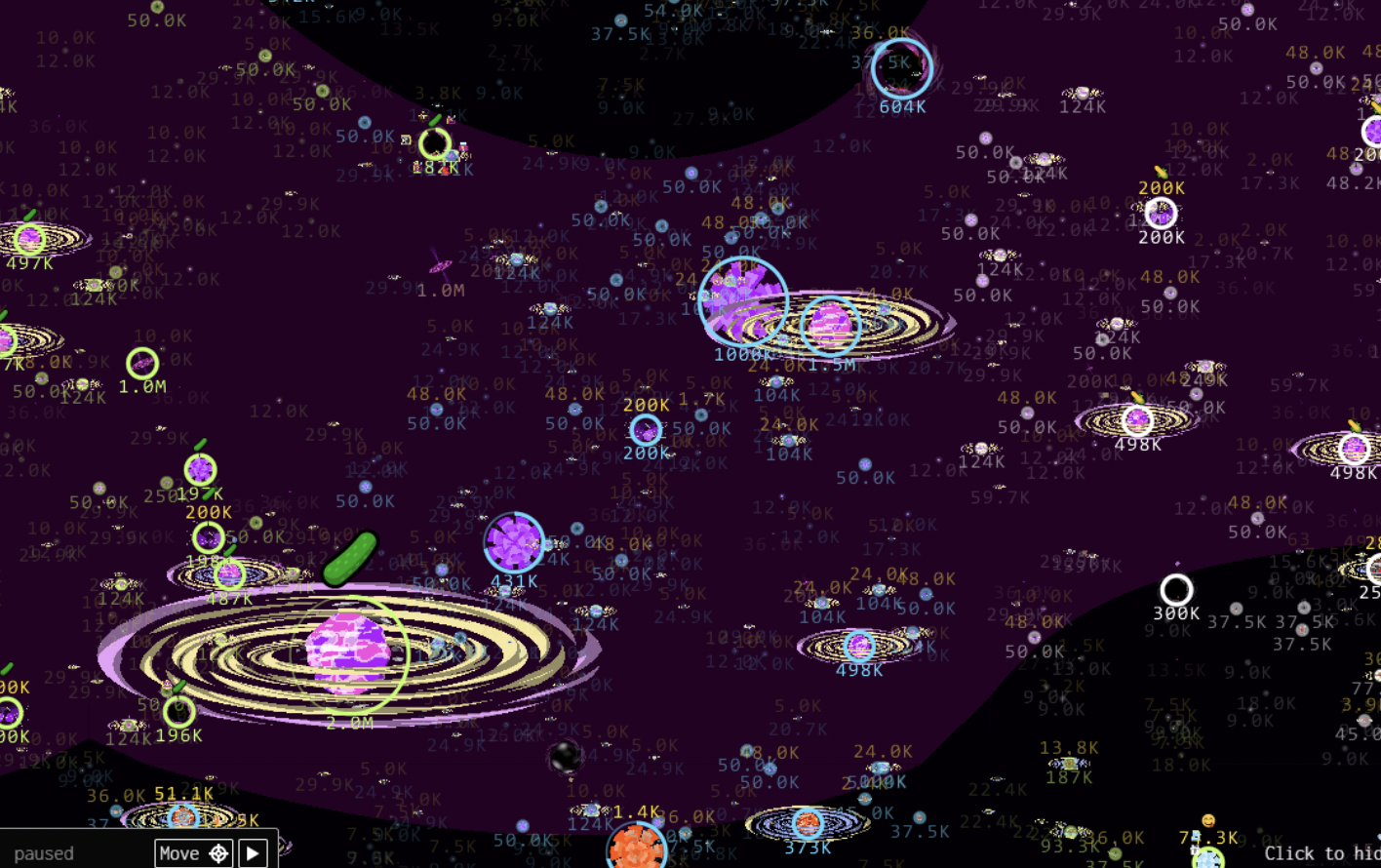
The green player is 0x000da38758, the blue planets are the neutral zone, and the white player is me. Throughout this section, all strategies will be visualized through the white player’s perspective.
Although this map may look like a convoluted mess based on the amount of planets and the randomness to their locations, something that can help clear up priority targets is to first identify where planet voids exist. Through this filtering method, strategic areas such as outposts or large patches of contestable silver become apparent.
This can be better visualized through the heatmap plugin (although I would generally not recommend using this during an actual war, this is only to give a rough visualization):
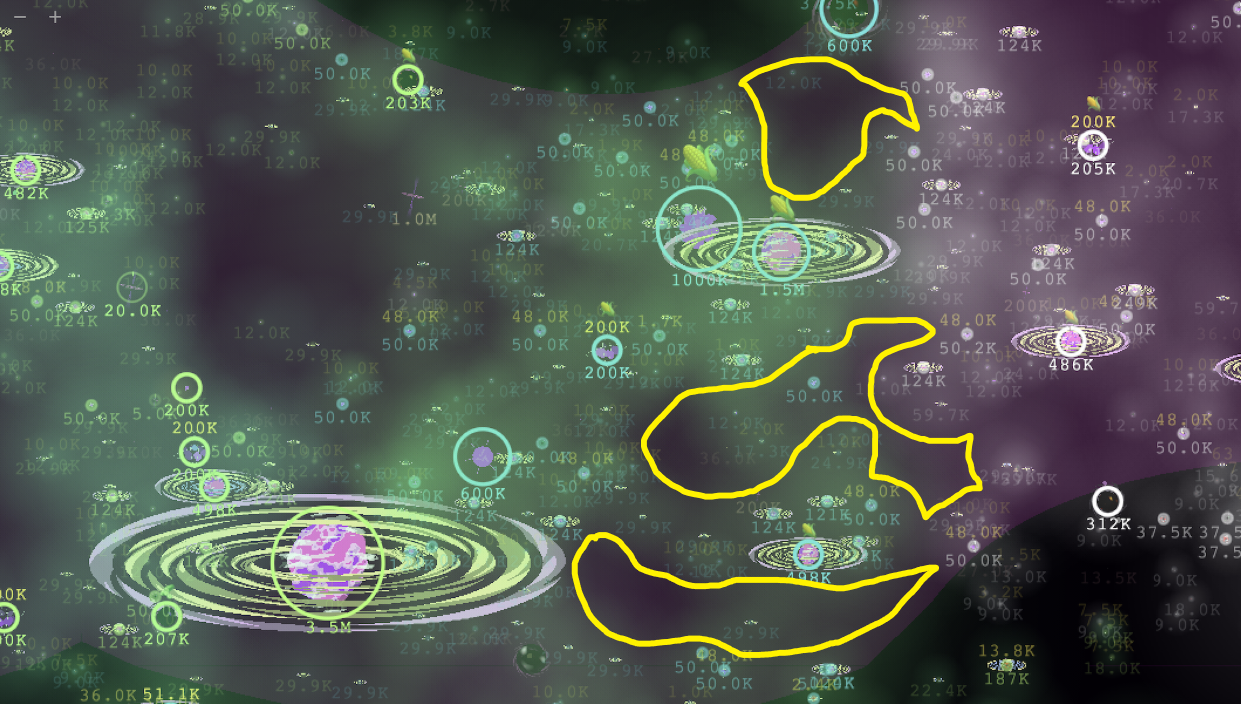
The yellow areas represent nearby planet voids. Through this plugin, it becomes clear what places can serve as powerful outposts, where the front line in the war will likely first take place, and what areas can serve as important sidelines for flanking the enemy.
Once points of interests are identified, they now have to have a certain priority assigned to them. Normally priority of certain areas will be assigned through a combination of aspects such as:
- The current planets that are in range
- How close the enemy is to them compared to how close you are
- How long it’ll take to capture the area
- The overall amount of resources/resource regeneration in the area
- The impact it has on your position if it was captured by the enemy as well as the reverse of this
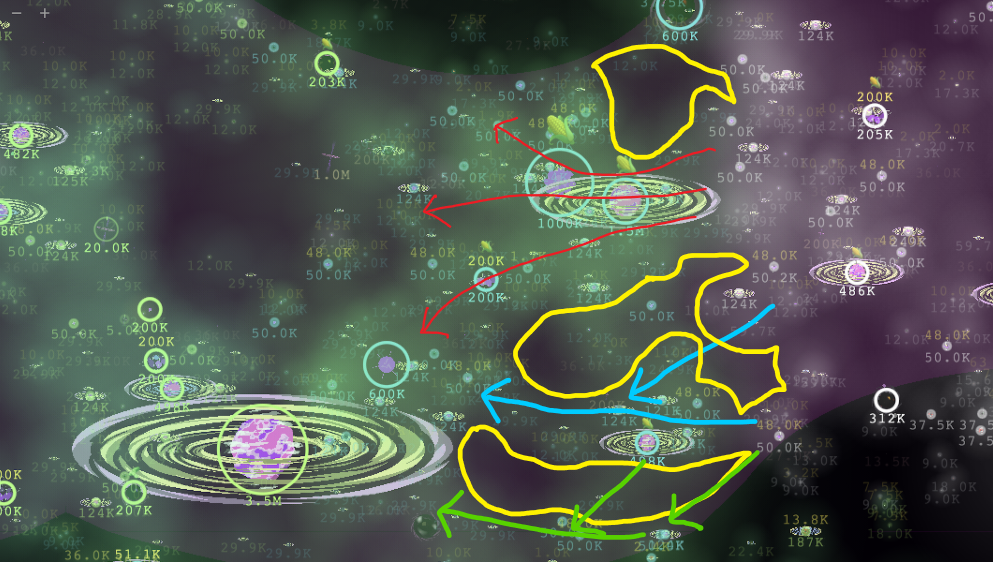
Visualizing this on the current battlefield, it can be seen that pushing along the red line seems to make the most sense due to it essentially being a massive highway with high planet density. Both players have easy access to this area, which makes it serve as the primary front line in the war. However, although it may take the green player slightly longer to set up, once they do get set up, their front line has far more surface area facing your own front lines, making the war harder, thus increasing the importance of rapidly expanding as much as possible along the red line.
Along the blue line is slightly more remote, however it’s much easier for you to access than the enemy. Although the aforementioned concave along the front lines against you seems inevitable, this outpost along the blue line could balance this out while also stemming the weak link that the enemy has to this area with their level 3s along the green line. Therefore, it would make sense to divert a portion of the resources used to expand along the red line over to expanding along the blue line.
The green line is extremely remote when compared to the rest of the battlefield, but it still serves a purpose in the late-game of the war given the ability to slightly surround the enemy’s massive level 8 planet (and the outposts surrounding it). However, because of how remote it is and ineffectual it is, it gets a very low expansion priority at the start of the war.
Now that the overall strategy for expansion has been taken care of for the start of the war, the actual PvP portion of the war needs to be explained.
To judge areas of interest during the war, details such as:
- Overall planet defense of an area
- Planet-to-energy regeneration ratio
- Your attack/defending potential in that area
- The enemy’s attack/defending potential in that area
- The impact it has on your position if it was captured by the enemy as well as the reverse of this
This criteria is fairly similar to the one on assigning points of interest while expanding.
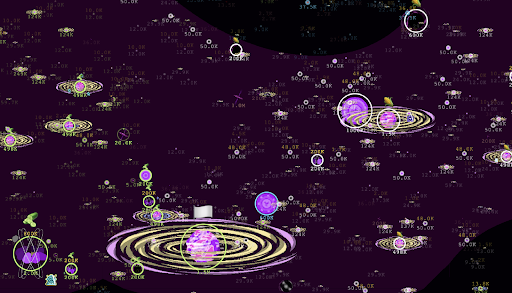
This planet setup will be used as an example starting position, with us playing as the green player this time and our enemy being the white player. The blue player is neutral.
This situation looks rather dire for us, as the player in white has level 4s surrounding our level 8s, along with them having the overall concave on our position. However, something important to note is that much of a battle is determined by how much energy can be delivered to the front line from either side. In this case, the green player has the clear advantage.
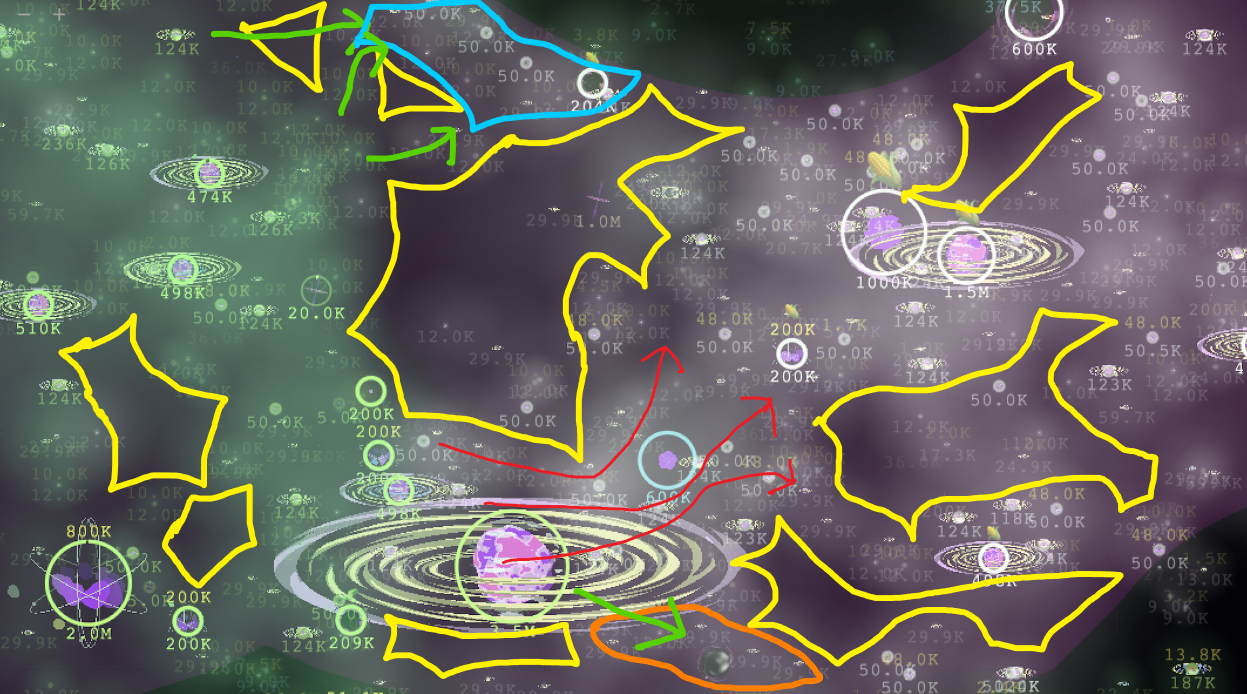
As for which area to focus attacks on, the clear choice is to push along the red line and around the level 8. However, there are also other viable attack paths shown along green lines.
Identifying planet voids again, it can be seen that there isn’t all that much to support the northern or the southern side of this war for either side, both of which are fairly annoying when left on their own. For the northern side inside the blue region, the overall planet defense along with the energy regeneration is fairly low due to much of the larger planets there being spacetime rips. There are also going to be several level 4s that will be far away from the front lines, however are closer in proximity to the northern planets. For the southern side, there’s a thin line of level 3s that can easily be blocked off once any support that’s within the orange circle has been cut off. Once the northern and southern side are at least contested, the concave ceases to exist, and the main battle starts along the red line.
Tactics
Tactics in this game are more so how well a player can control their planets. They are the tools used to execute the aforementioned strategies effectively. It’s also often the case that the usage of plugins in creative ways can aid a player in carrying out these tactics as well.
Strategies and tactics in Dark Forest have greatly expanded since v0.3. However, the vast majority of said strategies and tactics have remained unused by much of the playerbase so far, and would take too long to explain each of them, especially since a large portion are viable only in very specific situations. As a result, it would be a lot more efficient to identify some common misunderstandings while also identifying how to discover and create new tactics. This hopefully will aid the creation of new tactics in the form of building blocks.
Although this sounds obvious, wars are almost entirely decided by available energy regeneration and range in various locations. With this information in mind, questions that are often asked during wars are:
- How can I preserve energy at the front lines with maximum efficiency?
- How can I deal critical blows to the enemy’s important sources of energy/energy regeneration?
- How can I bring together and utilize energy across my entire empire to assist in a war?
Combining these questions with game knowledge, we can take down two fairly common misunderstandings of battle:
- Just because your opponent captures a planet, it doesn’t mean that they have gained the significant upper hand in that location - ownership over a planet means nothing if the planet doesn’t have time to start producing energy at a sufficient rate. This also means that a planet with close to zero energy will take an extremely long time before it becomes useful, due to planets not regenerating at a linear rate.
- Just because your opponent has more high-level planets, it doesn’t mean that they automatically have a significant advantage - Although high-level planets have a high energy capacity, they aren’t very good at achieving that on their own. It’s almost always the case that a few smaller planets can outmatch the energy regeneration rate of a high-level planet, rendering it useless without support.
With these out of the way, specific tactics can finally be covered.
Energy Swapping
Use Case - Enemy attack inbound on a friendly planet with less than ~90 defense.
Execution - Send an attack to the target planet that lands directly after the enemy’s attack lands, then right before the enemy’s attack land transfer all the energy from the target planet to somewhere else. The Voyage Time plugin can help immensely with timing these swaps.
Why this works - If a planet has less than 100 defense, then an enemy’s attack will deal more damage than its amount of arriving forces, effectively boosting the power of the attack. However, energy that is en route to another planet can not be intercepted, meaning that if all your forces on a planet that’s about to be attacked has been sent off, then the boost of the enemy’s attack won’t affect the amount of energy that the target planet initially had, effectively preserving your energy potential. Adding onto one one of your defending moves landing right after the enemy’s, this time the enemy has the short end of the stick when it comes to the planet defense.
Front-line Energy Interception
Use Case - An enemy front line that seems unbreakable without large planet support.
Execution - Send a fairly large attack to a large planet just behind the enemy’s side of the front lines, then spread the energy out over various smaller planets.
Why this works - Support from further back is necessary in order to keep the front lines from crumbling, and the support normally comes in the form of level 3/4 planets. That means that to advance onwards and take over a new area, support to that area needs to be cut off somehow, at least for a period of time. Once that’s done, it becomes much easier to leverage the advantage of having closer energy regeneration while your large attack effectively stalls the back lines of the enemy from sending forces to their front lines
Photoid Cannon Denials
Use Case - An enemy is massing forces or has a crucial artifact on a certain planet.
Execution - Prepare a Photoid Cannon on a long range level 4 planet from the back lines beforehand, then send an attack from it to the target planet.
Why this works - This one is pretty self-explanatory, the opponent has something important, utilize energy from the back lines with a Photoid Cannon and neutralize it.
Final Thoughts
Dark Forest PvP, in my eyes, is far from perfect when compared with other gameplay styles. This isn’t necessarily a bad thing however. Looking at the development of other aspects of the game gives me confidence that depending on what the game encourages, the playerbase will have no problem figuring out optimal strategies to fit the objective of the game.
Only now are active predictive strategies on the battlefield starting to develop, and these skills are going to be viewed as commonplace in future Dark Forest PvP. It is my prediction that in the years to come, PvP will be executed with player mechanics far more precise and active than that of which exists in any Dark Forest player today. If this guide does serve as a sufficient stepping stone to that, I very much look forward to seeing and facing off against the new interesting strategies you all can come up with in future rounds, and intend to see the continuous development of them for a long time.
For now though, amongst the chaos that is Dark Forest, I hope to see you all in the metaverse. GLHF!